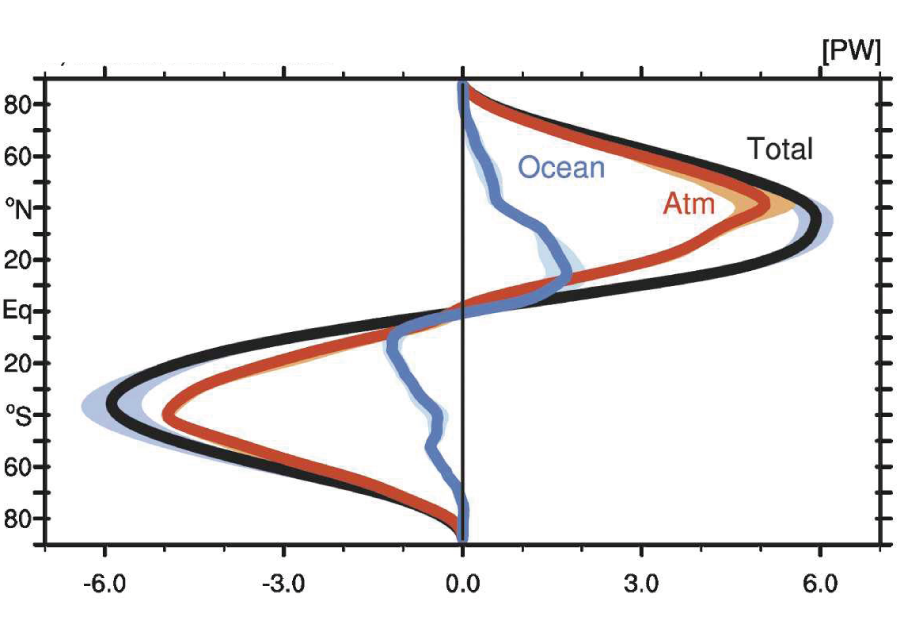The Earth's meridional heat transport
Author: Benjamin Meier, Revised by: Julia Wouters
The meridional heat transport is related to earth's radiation budget. The energy absorbed at a given point on earth is determined by it's latitudinal location. The tropical regions on average receive the most solar radiation per year (see fig. 1). Towards the poles the intensity of the radiation declines, which means there is an uneven distribution of incoming energy. This imbalance would lead to a gradual cooling of the poles and a warming of the tropical regions. Since this is not the case, the net energy loss at the poles has to be compensated by the net energy gain in tropical regions.Long wave radiation emitted by the earth is slightly higher at lower latitudes but still not high enough to balance the system. Therefore, heat has to be transported from high latitudes polewards. This energy or heat transport can either occur through the atmosphere or through the ocean, it is called the meridional heat transport.
Fig. 1: Net surface shortwave radiation. The overall trend is a decrease of net solar radiation towards the poles. This is due to the inclination of the earth's rotation axis, which leads to less sunlight radiation reaching the surface of the poles (longer traveling distance). However the smaller scale patterns are determined by the cloud coverage and surface albedo. That's why slightly north of the equator (clearly visible in the Atlantic and Pacific) there is a “low-radiation band”, where the ITC-Zone with strong convection leads to a high cloud coverage. On the other hand the lower net solar radiation over the Sahara and other deserts compared to the ocean at same latitudes, is explained by the higher albedo and therefore higher reflectivity of deserts.
Atmospheric versus oceanic heat transport
It is not easy to estimate the total meridional energy transport. This is done by computing the net energy gain in the tropics at the top of the atmosphere (TOA) and the net energy loss at the TOA of high latitudes. The excess respectively deficit of the energy budget is balanced by the meridional energy transport. The maximum of 6 PW (6 * 1015 Watts) heat transport is reached at around 35° N/S in the dynamically highly active regions.
In relative terms the oceanic meridional heat transport is weaker than the atmospheric, except in the tropics, where the proportions are of the same order (see fig. 2). At 35°N the ocean accounts for about 20% of the total meridional heat transport whereas at 35°S it is less than 10%. The reason for this is that there is more ocean in the southern hemisphere and the northward transport of heat across the Equator in the Atlantic Ocean. At very high latitudes almost exclusively the atmosphere is important for the transport of heat. However this overlooks regional inhomogeneities. For example the gulf stream plays an important role in the warmer climate in NW-Europe, even though the atmospheric circulation is much more dominant there. In general the oceanic heat transport is most important in subtropical regions, which is related to the ocean circulation.
Fig. 2: The oceanic and atmospheric meridional heat transport in Petawatt per latitude
Characteristics of the heat transport
The oceanic heat transport is due to the advection of warm water into colder regions. The absorbed radiation warms the ocean surface layer and the energy is then transported polewards, e.g. in the western boundary currents of the subtropical gyres. Because of the high heat capacity of water, the oceanic heat transport is more regulated than the atmospheric. Also, during winter, the extension of the gulf stream (North Atlantic Current) transports a lot of energy towards northwestern Europe.
The atmospheric heat transport is largely driven by latent heat fluxes, thus indirectly influenced by the ocean. The evaporated water condensates later in the atmosphere and releases heat somewhere else. This is for instance done by cyclonic activities in the westerlies or tropical cyclones reaching extratropical regions, as illustrative examples. Therefore the latent energy is transported from one place to another. Lastly sensible heat flux matters. On the surface absorbed solar radiation heats the air above and through winds this heat is transported, which means a net warm air advection towards the poles occurs as well.
Sources:
- Brown, E. et al (2001): Ocean Circulation, Elsevier Ltd.
- Stewart, R. H. (2008): Introduction to physical Oceanography, Texas A & M University.
- Talley, L. D. et al (2011): Descriptive Physical Oceanography: An Introduction, Academic Press

